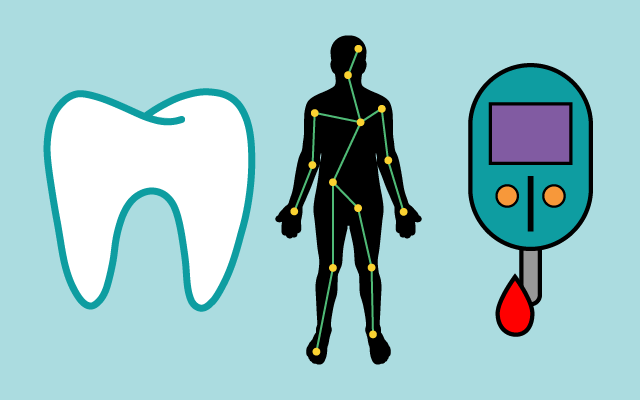Recap: What is the Oral-Systemic Connection?
New research is revealing the intricate connections between the health of our mouths and the health of our bodies. Conditions like cardiovascular disease (heart disease), diabetes, osteoporosis, Alzheimer’s Disease, and many others have significant connections to oral health.
If you missed it, be sure to read part one of our three-part series, “Healthy Mouth, Healthy Body,” where we cover the connections between gum disease and heart disease. In this post, we’ll travel from the hart through the blood vessels to explore diabetes adn its connections to oral health.
Review: The Oral-Cardiovascular Connection
Gum disease, or periodontal disease, can allow harmful bacteria to enter the blood stream and can cause chronic inflammation. Chronic inflammation is linked to many harmful diseases, like atherosclerosis, an artery disease that can lead to heart attacks and strokes.
Healthy Mouth, Healthy Blood
Gum disease and diabetes are complexly intertwined. Gum disease can increase the risk of diabetes, AND diabetes can increase the risk of gum disease.
Here’s how it breaks down:
To start, diabetes can cause dry mouth (xerostomia). Your saliva is a powerhouse, defending against cavities by cleaning your mouth and controlling its pH balance. So, if you have dry mouth, reduced levels of that cavity-fighting saliva decreases the impact of its antimicrobial functions. And, your mouth’s pH may even become imbalanced, increasing how quickly plaque can develop and build up.
Additionally, since diabetics have delayed healing, one with active oral disease can be at a greater risk of infection following a tooth extraction and other surgical procedures.
On the flip side, gum disease is also linked to multiple causes of diabetes. Unmanaged gum disease can lead to chronic inflammation and increased blood glucose levels, both of which are important risk factors for diabetes.
What Does This Mean?
Our Habits Play a Role in the Oral-Systemic Connection
When thinking about oral-systemic connections, it is important to consider the causes, as well as the connections and outcomes. For example, increased sugar intake is both a risk factor for developing diabetes and a risk factor for developing cavities and periodontal disease. There are many other habits, such as tobacco use, that also impact your oral health and the health of other parts of the body.
Emerging research into the oral-systemic connection and the prevalence of these diseases highlight just how important it is that everyone have access to both oral health care and general health care.
Gum disease and diabetes are both incredibly common conditions. Gum disease affects 75 percent of adults in the United States, and nearly all Americans (about 91 percent of adults over 20) have tooth decay, according to the CDC. More than 100 million (about 33 percent) of Americans have either diabetes or prediabetes.
At NCOHC, we focus especially on those who lack access to optimal oral health care. The demographic characteristics of communities that chronically lack access are very similar to those with higher rates of diabetes. (For more on this, see our post about systemic barriers and oral health equity).
It is incredibly important that we address systemic barriers to oral health care, and to health care in general, to make sure that vulnerable populations get the care they need to live healthy lives.
Additionally, given the links between diabetes and oral disease, medical practices that treat patients with diabetes should understand how to recognize symptoms of oral disease. Conversely, dental practices should be aware of how diabetes plays a role in oral health outcomes.
This is why we support advancing integrated care models, where dental practices and medical practices alike are equipped with the tools necessary to positively impact both sides of the oral-systemic connection.
Stay tuned for the final part of this three-part series, focusing on the connection between oral health and pregnancy. We will publish this final post on February 11.(Follow us on our brand new Facebook page and we’ll let you know when we publish new content!)
Sign up for NCOHC’s newsletter list to receive updates on stories like this one directly to your inbox.
NCOHC is a program of the Foundation for Health Leadership & Innovation. For more information and to stay up to date, subscribe to the NCOHC newsletter. If you are interested in becoming an NCOHC member, you can also fill out our membership form. It’s free!
Additional Sources for Information on the Oral-Systemic Connection
- https://www.ncbi.nlm.nih.gov/pmc/articles/PMC3100856/
- https://www.ada.org/en/member-center/oral-health-topics/oral-systemic-health
- https://spectrum.diabetesjournals.org/content/24/4/187
- https://www.cdc.gov/diabetes/ndep/pdfs/ppod-guide-dental-professionals.pdf
- https://link.springer.com/article/10.1007%2Fs10995-014-1632-7
- https://www.ada.org/en/member-center/oral-health-topics/pregnancy
- https://www.ncbi.nlm.nih.gov/pmc/articles/PMC5303728/
- https://www.ncbi.nlm.nih.gov/pmc/articles/PMC3941365/
- https://www.nytimes.com/1996/10/09/us/gum-disease-in-pregnancy-linked-to-premature-low-weight-babies.html
- https://www.health.harvard.edu/heart-health/gum-disease-and-heart-disease-the-common-thread






